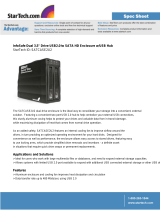
Dell
Dell PowerEdge R910 Technical Guide iv
7.5 Sparing ................................................................................................... 28
7.6 Mirroring ................................................................................................. 28
7.7 RAID ...................................................................................................... 28
7.8 Supported Configurations ............................................................................. 28
8 Chipset ........................................................................................................ 29
8.1 Intel 7500 Chipset I/O Hub (IOH) .................................................................... 29
8.2 IOH QuickPath Interconnect (QPI) ................................................................... 29
8.3 PCI Express Generation 2 ............................................................................. 29
8.4 Direct Media Interface (DMI) ......................................................................... 29
8.5 Intel I/O Controller Hub 10 (ICH10) ................................................................. 29
8.6 PCI Express Connectors ................................................................................ 30
9 BIOS ............................................................................................................ 31
9.1 Overview ................................................................................................ 31
9.2 I2C ........................................................................................................ 31
10 Embedded NICs/LAN on Motherboard (LOM) ............................................................. 32
10.1 Overview ................................................................................................ 32
10.2 Option 1: 1GbE I/O riser .............................................................................. 32
10.3 Option 2: 10Gb I/O riser .............................................................................. 32
11 PCI Slots ....................................................................................................... 33
11.1 Overview ................................................................................................ 33
11.2 Quantities and Priorities .............................................................................. 33
11.3 PCI Card Dimensions ................................................................................... 33
12 Storage ........................................................................................................ 34
12.1 Overview ................................................................................................ 34
12.2 Backplanes .............................................................................................. 34
12.2.1 2.5” x4 Backplane ................................................................................ 34
12.2.2 2.5” x16 Backplane .............................................................................. 34
12.3 Flash BIOS Memory ..................................................................................... 34
12.4 Drives .................................................................................................... 34
12.5 RAID Configurations .................................................................................... 35
12.6 Storage Controllers .................................................................................... 37
12.6.1 PERC H200 ......................................................................................... 37
12.6.2 PERC H700 ......................................................................................... 37
12.6.3 PERC H800 ......................................................................................... 38
12.6.4 Storage Card Support Matrix .................................................................... 38
12.7 LED Indicators .......................................................................................... 39
12.8 Optical Drives ........................................................................................... 39
13 Video ........................................................................................................... 40
14 Rack Information ............................................................................................. 41
14.1 Overview ................................................................................................ 41
14.2 Rails ...................................................................................................... 41
14.3 Cable Management Arm (CMA) ....................................................................... 42
14.4 Rack View ............................................................................................... 42
15 Operating Systems ........................................................................................... 44
16 Systems Management ........................................................................................ 45
16.1 Overview ................................................................................................ 45
16.2 Server Management .................................................................................... 45
16.3 Embedded Server Management ...................................................................... 46
16.4 Dell Lifecycle Controller and Unified Server Configurator ....................................... 46
16.5 Integrated Dell Remote Access Controller .......................................................... 46
16.6 iDRAC Express........................................................................................... 47
16.7 iDRAC6 Enterprise ...................................................................................... 47
16.8 iDRAC6 Enterprise with Virtual Flash (vFlash) Media ............................................. 47




















